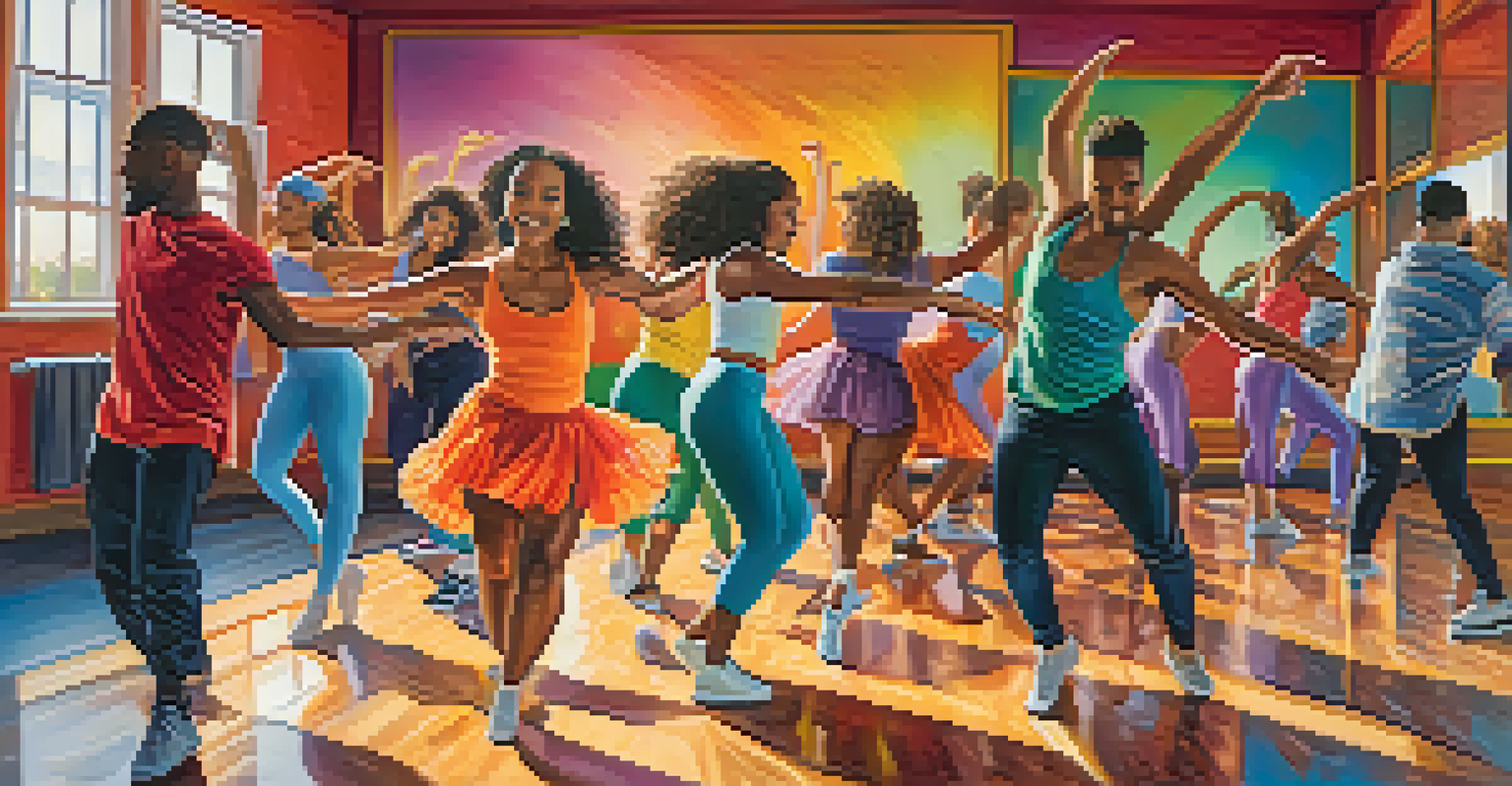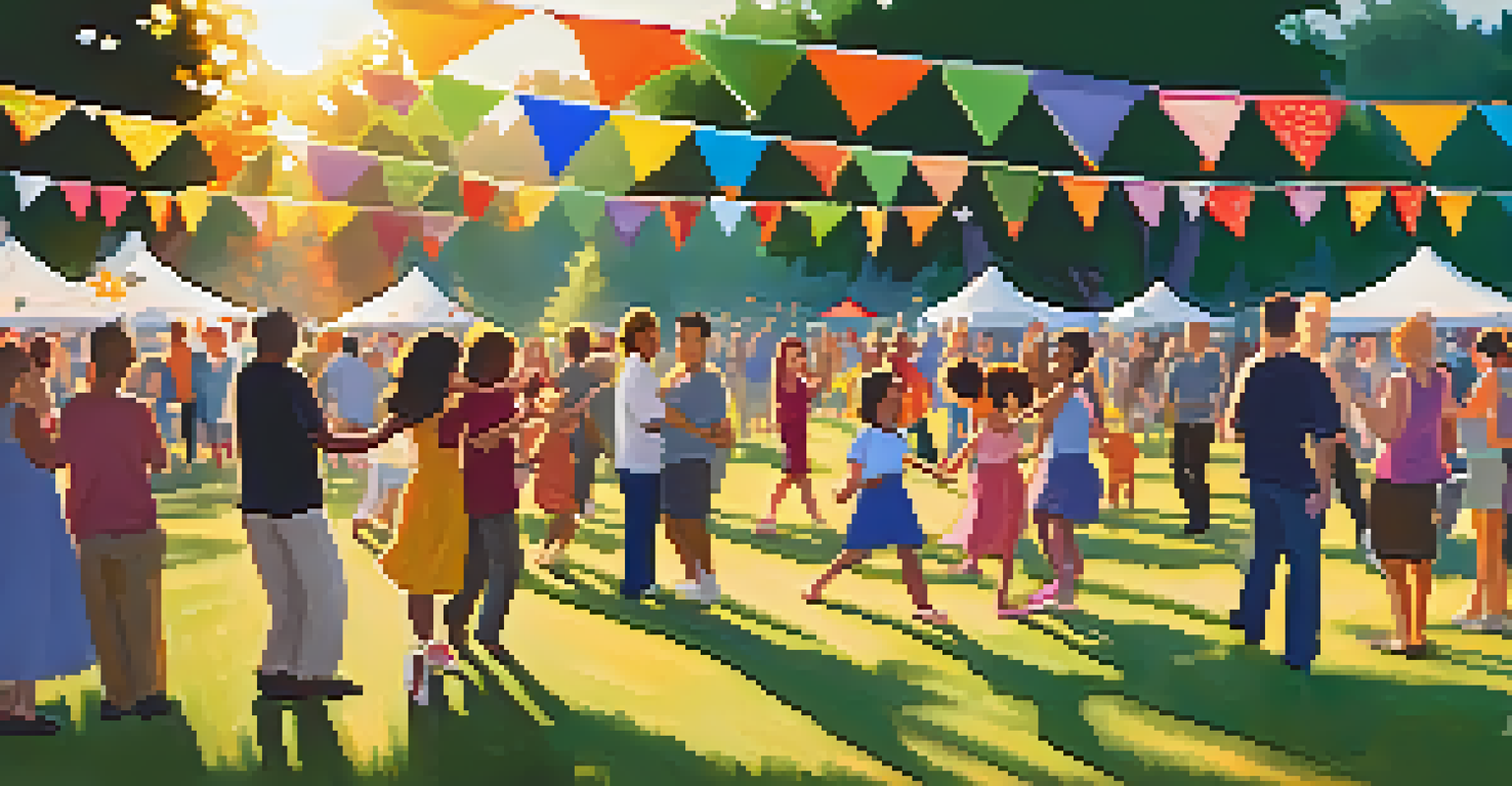Dance as a Tool for Enhancing Emotional Well-Being

Understanding the Connection Between Dance and Emotions
Dance is more than just a physical activity; it’s a profound expression of emotions. When we move to music, our bodies often mirror what we feel inside, creating a unique connection between our physical and emotional states. This connection can be healing, allowing individuals to process feelings that might otherwise be difficult to express verbally.
Dance is the hidden language of the soul.
For many, dance serves as a therapeutic outlet, helping to release pent-up emotions and stress. By engaging in dance, people can tap into their feelings, whether it’s joy, sadness, or anger, and channel them into movement. In this way, dance acts as an emotional release valve, fostering a sense of relief and clarity.
Moreover, research has shown that participating in dance can stimulate the production of endorphins, the body's natural feel-good hormones. This biochemical reaction not only elevates mood but also enhances overall emotional well-being, making dance a powerful tool in managing everyday life’s ups and downs.
Dance as a Form of Self-Expression
One of the most beautiful aspects of dance is its ability to serve as a personal language. Each dancer interprets music and movement in their own unique way, allowing for a rich tapestry of emotional expression. This individuality fosters a sense of identity and personal connection to one’s feelings.

Through dance, individuals can express thoughts and emotions that may be challenging to articulate. For instance, a dancer might use swift, sharp movements to convey frustration or slow, flowing motions to express peace and contentment. This freedom to express oneself can lead to increased self-awareness and confidence.
Dance as Emotional Expression
Through movement, dance enables individuals to express complex emotions that might be difficult to articulate verbally.
Additionally, dance encourages creativity, allowing individuals to explore and experiment with their emotions. This exploration can foster a deeper understanding of oneself, ultimately leading to greater emotional intelligence and resilience in the face of life’s challenges.
Building Community through Dance
Dance is often a communal activity, bringing people together in shared experiences. Whether it’s a group class, a dance party, or a cultural celebration, the social aspect of dance can enhance emotional well-being by fostering connections with others. These interactions create a sense of belonging and support, which is essential for mental health.
Dancing is like dreaming with your feet.
Participating in dance communities can also help individuals build friendships and social networks. These connections can be a source of encouragement and motivation, helping people feel more supported in their emotional journeys. The camaraderie that develops through shared movement can be incredibly uplifting.
Furthermore, engaging with others through dance can reduce feelings of isolation and loneliness. In a world where many people feel disconnected, dance offers a way to find community, share experiences, and support one another through the highs and lows of life.
Dance as a Stress Reliever
In today’s fast-paced world, stress is a common challenge that many people face. Dance provides a joyful escape from daily pressures, allowing individuals to immerse themselves in movement and music. This shift in focus can effectively alleviate stress and anxiety, creating a sense of peace.
The rhythmic nature of dance can also promote relaxation. As individuals move in sync with music, they often find themselves in a meditative state, where worries fade and the mind quiets. This form of active meditation can be incredibly beneficial for emotional health.
Building Community Through Dance
Participating in dance fosters social connections, providing a sense of belonging and support that enhances emotional well-being.
Moreover, regular dance practice can help develop coping strategies for dealing with stress. As individuals learn to express their emotions through movement, they may find healthier ways to manage stressors in their daily lives, leading to a more balanced and resilient mindset.
The Role of Dance in Personal Growth
Engaging in dance can be a transformative experience that promotes personal growth. Through the act of dancing, individuals often confront their fears, insecurities, and limitations. Overcoming these challenges can lead to increased self-esteem and confidence in one’s abilities.
Dance also encourages a sense of discipline and commitment. Whether practicing for a performance or attending regular classes, the dedication required can translate into other areas of life, fostering a stronger work ethic and resilience. This sense of achievement can be a powerful boost to emotional well-being.
Ultimately, dance offers a pathway to self-discovery. As individuals explore different styles and techniques, they may uncover hidden talents or interests, leading to a deeper understanding of themselves and their emotional landscapes.
Dance Movement Therapy: A Professional Approach
Dance movement therapy (DMT) is a formal therapeutic practice that harnesses the power of dance to promote emotional and physical well-being. Guided by a trained therapist, individuals can explore their emotions through movement in a safe and supportive environment. This structured approach can be particularly beneficial for those dealing with trauma or mental health challenges.
During DMT sessions, participants are encouraged to express their feelings through movement, which can lead to profound insights and healing. This therapy not only addresses emotional issues but also fosters physical awareness and body connection, enhancing overall well-being.
Dance as Stress Relief
Engaging in dance offers a joyful escape from daily stressors, promoting relaxation and a positive shift in focus.
Research has shown that DMT can improve mood, reduce anxiety, and increase self-esteem. By integrating movement with emotional expression, dance becomes a therapeutic tool that can facilitate healing and personal growth in a unique and impactful way.
Incorporating Dance into Daily Life
Incorporating dance into daily routines doesn’t have to be complicated or time-consuming. Simple activities like dancing in the living room, joining a local dance class, or even participating in online dance sessions can make a significant difference in emotional well-being. The key is to find joy in movement and make it a regular part of life.
Even brief dance breaks throughout the day can help rejuvenate the mind and body. A few minutes of moving to your favorite song can lift your spirits and reduce stress, making it an easy and enjoyable way to enhance emotional health.

Ultimately, the goal is to embrace dance as a form of self-care. By prioritizing movement and making time for dance, individuals can cultivate a deeper connection to their emotions, foster resilience, and enhance overall emotional well-being.